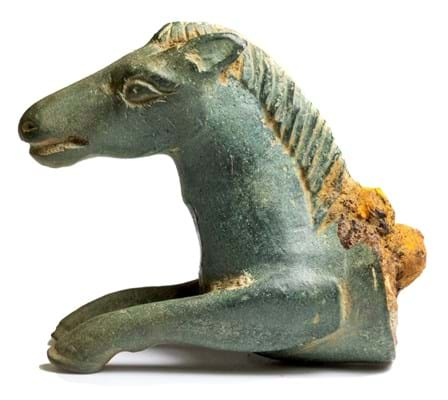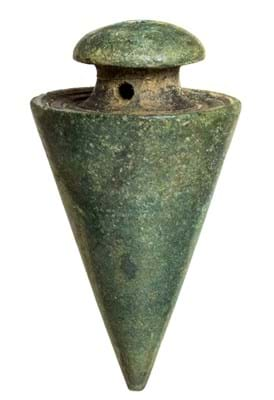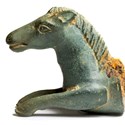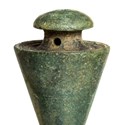
Discovered by metal detectorists in Ryedale, North Yorkshire, the four items at the auction in Etwall, Derbyshire on May 20 combined elements of classical craftsmanship with native Celtic art and were likely the products of a provincial Romano-British workshop.
The 5in (13cm) high bust which appeared to represent the last of the ‘Five Good Emperors’ was found along with a statuette of the god Mars on horseback, a horse-head knife handle and a pendulum. They were offered as a single lot with a £70,000-90,000 estimate.
While Hansons received several private offers before the sale, four bidders (three on the phone and one online) competed for the lot at the auction and it was eventually knocked down at £185,000 (plus 30% buyer’s premium inc. VAT) to London-based gallery David Aaron who were bidding on the phone.
The auction house confirmed to ATG that museum interest had also emerged.
Salomon Aaron of the ancient art specialist said: “We do not have a specific client in mind but could not pass on the opportunity to acquire such a rare, beautiful and historically important group of bronzes. We would never permit the works in this group to be separated and we will handle these bronzes with the utmost respect and care.”
The bronzes were found by two metal detectorist friends in May 2020 approximately 20 miles north of York (the Roman city of Eboracum) and not too far from the Roman Fort at Malton. The works were almost certainly buried together as a single deposit in the closing decades of the second century AD and are thought to represent a set of ritual equipment for a rural temple or shrine. The burial of the items may relate to the closure of the temple, perhaps in a later period after Christianity had become the dominant religion.
The hoard was taken to York Museum and recorded through the British Museum’s Portable Antiquities Scheme, meaning the proceeds of the sale will now be shared between the finders and the landowner.
Emperor bust
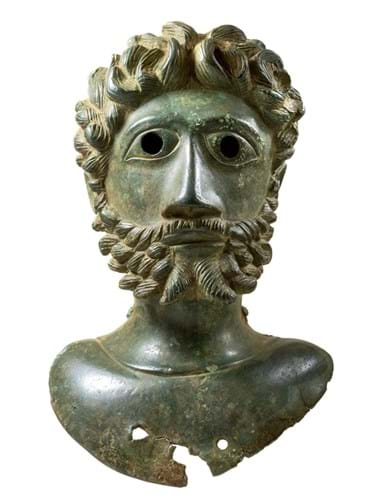
The bust of Marcus Aurelius discovered in Ryedale which sold as part of the group of Romano-British bronzes for £185,000 at Hansons. Image courtesy of Hansons.
The small bust was finely crafted in typical native Romano-British style with the hair and beard flamboyantly curled and the face featuring large lentoid eyes. It was thought that it would have been mounted originally as the head of a sceptre, possibly as an item of priestly regalia.
Adam Staples, Historica expert at Hansons Auctioneers, said of the figure: “He is indeed very lucky not to have been broken by his 1850 years spent underground. The bust survived extremely well and is in very fine condition with a glossy green patina.”
A similar head was found at Brackley, Northamptonshire in the 1970s and both examples not only date to the mid-late second century AD but also have a resemblance to images of Antonine emperors, especially Marcus Aurelius. The catalogue stated that around 20 bronze heads or busts of this type are known from Roman Britain.
Mars statuette
The other bronzes were also well modelled and were clearly made as high status objects. The auction house billed them as “offering a tantalising insight into the religious practices of Roman Britain in the 2nd century”.
The cast bronze of a rider on horseback, probably representing the God Mars, shows a figure wearing a helmet and would have originally held a spear in his raised right arm. It also has interesting details to the short-sleeved tunic, pleated skirt and belt at the waist, as well as to the horse itself.
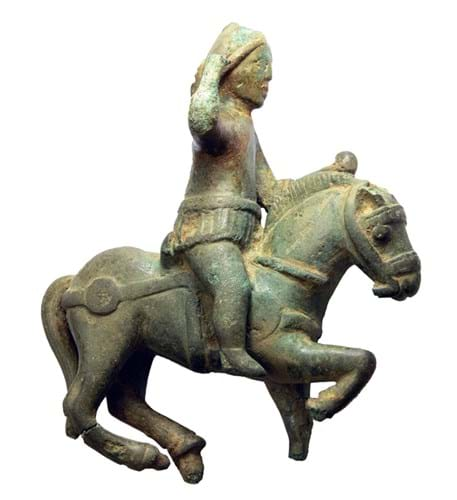
The statuette of the god Mars on horseback, part of the hoard discovered in North Yorkshire. Image courtesy of Hansons.
The solid bronze knife handle in the form of a horse protome (the foreparts of a horse) was modelled in a way to represent the animal leaping. It was suggested that the original knife may have been used in rituals of animal sacrifice or divination through the examination of animal entrails.
Meanwhile the large bronze pendulum, which was decorated with concentric circles, may have originally been a plumb bob – a tool for surveying and outlining building projects. Its religious function though is open to interpretation although the catalogue stated it was likely ‘used for the purposes of divination and predicting the future’.
Treasure Act
While the emergence of second century bronze items at auction is not unheard of, it was much rarer to have four works in a single offering. However auctions of such recently-dug works may soon be a thing of the past themselves as the UK government is soon expected to widen the Treasure Act to include important finds made in base metals like bronze, copper or tin.
Currently these items do not fit the legal definition of Treasure and instead come under the remit of the Portable Antiquities Scheme.
At the moment the Treasure Act applies only to items at least 300 years old and made substantially of gold or silver (or which are found with other artefacts of precious metals). Once an item is declared as Treasure, its market value is determined by the Treasure Valuation Committee and it will then be offered for a museum for first refusal.
If it is acquired by a museum, a reward up to the stated market value will typically be shared between the finder, the tenant and/or owner of the land on which the treasure was found.






